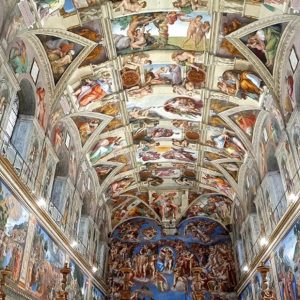On 1 November 1512, Michelangelo Buonarroti’s vast ceiling frescoes in the Sistine Chapel were formally shown to the public for the first time. The date was not chosen arbitrarily — it was All Saints’ Day, a major feast in the Catholic Church calendar. The patron, Pope Julius II, selected it to display the work on a significant day of celebration.
The chapel itself had been built under Pope Sixtus IV between 1473 and 1481. Its original ceiling was a simple star-spangled blue vault, decorated only with gold stars. By 1506–08 the ceiling was suffering structural issues and the Pope wished a far more substantial decorative scheme. He commissioned Michelangelo to take on the project in 1508.
Michelangelo initially resisted. He considered himself a sculptor rather than a painter and was already engaged on the Pope’s tomb. But the Pope insisted, and the contract was signed with Michelangelo securing a free hand over the subject matter.
What the frescoes depict
Spanning roughly 1508 to 1512, the ceiling covers about 12,000 ft² of surface and features more than 300 human figures in a complex narrative scheme. At its core are nine major panels depicting scenes from the Book of Genesis: including the Creation of Adam, the Fall of Man, Noah’s Flood and more.
One of the most iconic images is The Creation of Adam, where God and Adam stretch their fingers toward one another. The pose echoes the biblical verse “God created man in His own image”.
Michelangelo also placed prophets and sibyls around the narrative panels, and used architectural illusions to adapt the composition to the chapel’s vaults and curves.
Also read: A glimpse at the Sistine Chapel
Technique and Labour
Michelangelo painted in the fresco technique: applying pigment to wet plaster so the colours became part of the wall itself. He and his assistants stood on scaffold platforms built high above the floor; contrary to popular myth, he did not paint lying on his back.
The physical demands were enormous. Michelangelo later claimed that the strain of craning his neck and working overhead damaged his spine.
Public reception
When the ceiling was unveiled on 1 November 1512, the reaction was immediate and full of wonder. According to the 16th-century biographer Giorgio Vasari, “people from everywhere rushed to see it and were stunned into silence”. The work elevated Michelangelo’s reputation to such a degree that he became known as Il Divino.
Today the Sistine Chapel remains one of the most visited and celebrated sites in the art world. Over five million people per year view the ceiling frescoes, peering upwards into what Michelangelo described as “the theology of the human body”.
Restoration and the Present Day
By the 20th century, centuries of candle soot, dirt and smoke had dulled the frescoes. Between 1980 and 1999 a major restoration removed those layers, revealing vivid original colours. However, some critics argued the effect was too bright.
The chapel remains central to the Vatican: it is the site of papal conclaves and major ecclesiastical ceremonies. Recently, Britain’s King Charles III worshipped alongside Pope Leo XIII in the chapel, an historic moment.
Why the date matters
Choosing 1 November (All Saints’ Day) for the public unveiling underscored the connection between the divine themes of the ceiling frescoes and the Church’s liturgical calendar. It was a deliberate act: to frame the ceiling not just as art, but as a sacred act of worship and glory.






